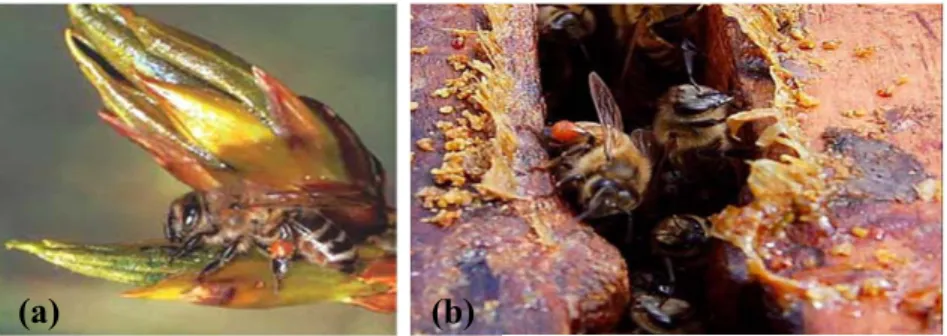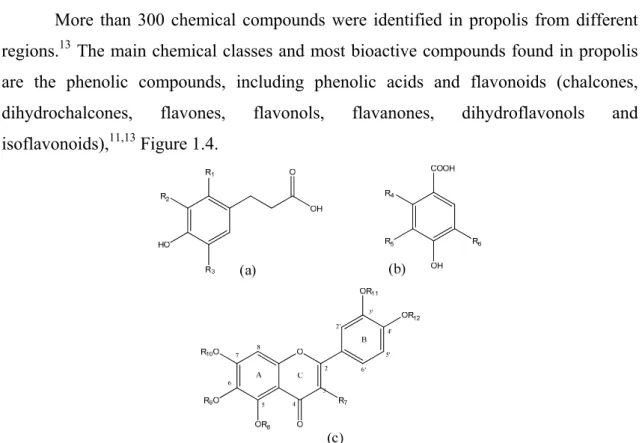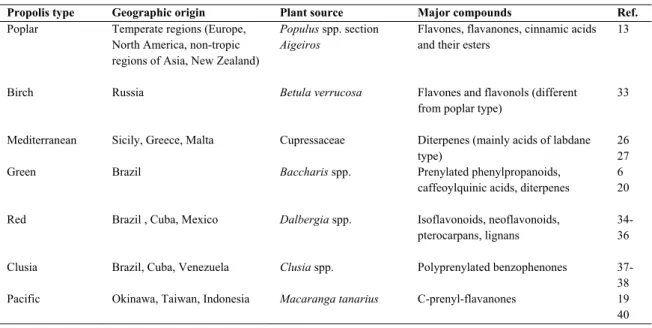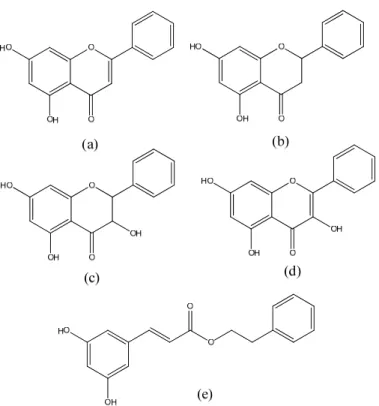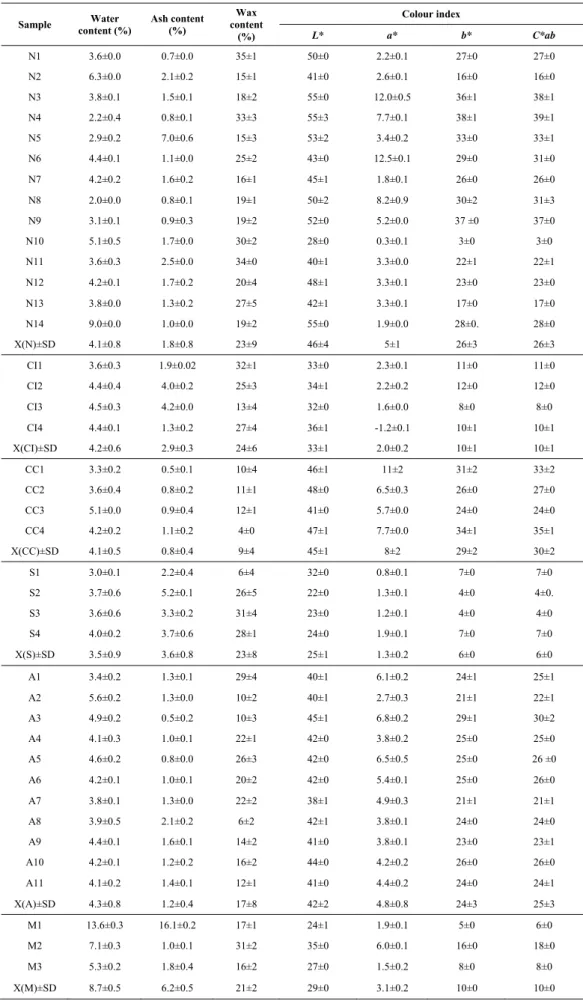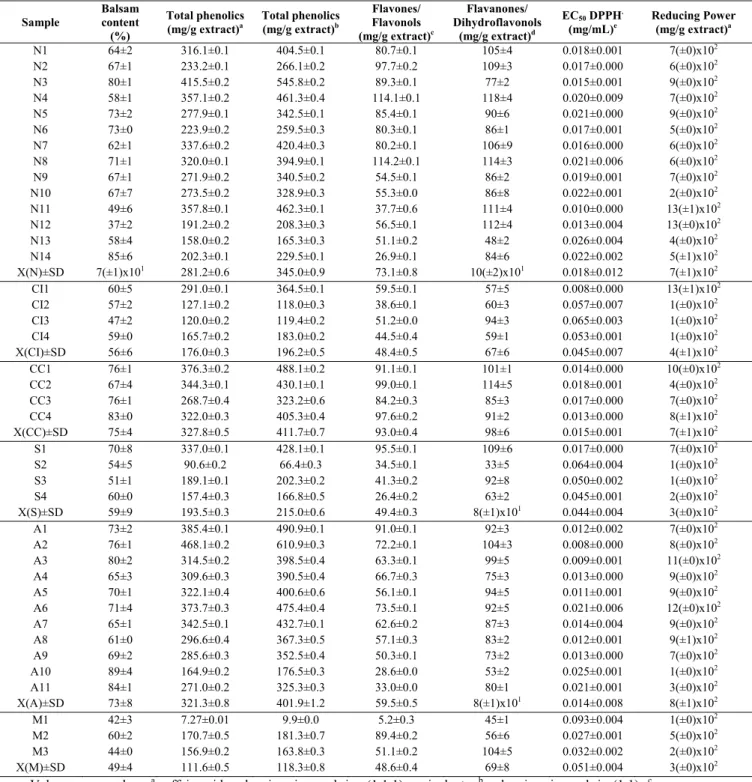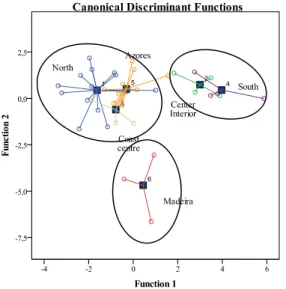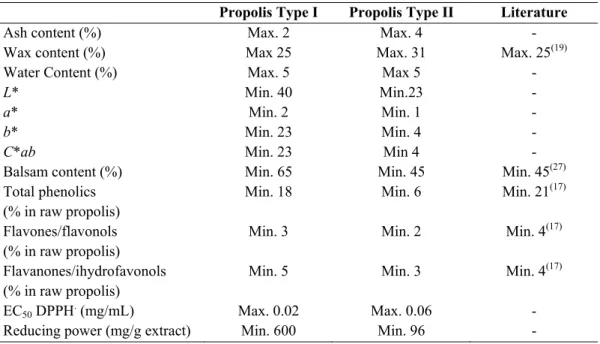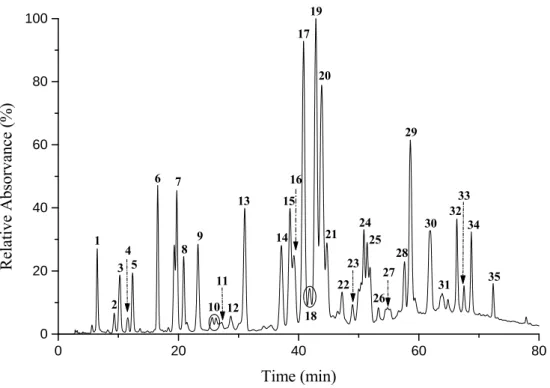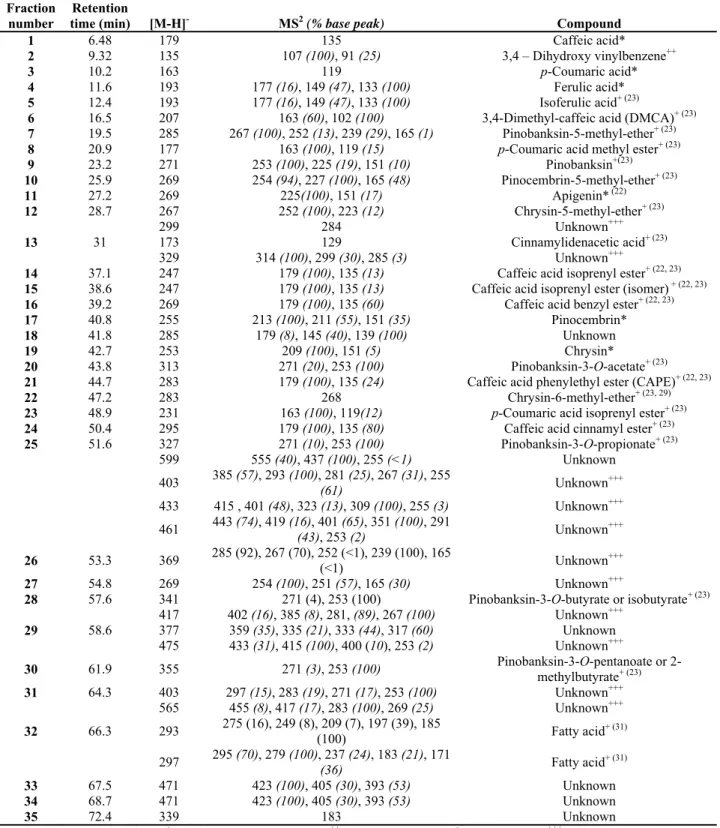CHEMICAL COMPOSITION OF
PORTUGUESE PROPOLIS
BIOACTIVE PROPERTIES
SORAIA ISABEL DOMINGUES MARCOS FALCÃO
Thesis submitted to the Faculty of Sciences of the University of Porto in partial fulfillment of the requirements for the
degree of Doctor in Chemistry
Supervisor: Professora Doutora Ana Cristina Moreira Freire Co-Supervisor: Professor Doutor Miguel José R. Vilas Boas
Acknowlegdments
To Fundação para a Ciência e a Tecnologia (FCT) for my PhD Grant with reference SFRH/BD/44855/2008 financially supported by program QREN-POPH-Tipology 4.1-Advanced Formation, European Social Fund and MCTES.
To Departamento de Química e Bioquímica, Faculdade de Ciências, Universidade do Porto for accepting me as a PhD student in the Doctoral Program of Chemistry.
To my supervisor, Professor Cristina Freire, for accepting to supervise my work, for her knowledge, the dedication in supervising this work, her friendship, the valuable advices and suggestions and the constant availability for helping me.
To my co-supervisor, Professor Miguel Vilas-Boas, for the excellent work and dedication in supervising, his knowledge and for the fruitful discussions. For always questing me about my results and the encouragement given in pursuing new scientific goals. For all the accomplished goals and above all for his friendship. To have worked under your supervision made me grow up and recognize that professional success is the result of the effort and dedication.
To Professor Ana Cristina Figueiredo from Departamento de Biologia, Faculdade de Ciências, Universidade de Lisboa for welcoming me so well during my research trainings/stay in Lisbon, and for the profitable discussions regarding volatile compounds, for revising my work, for her patience, friendship, sympathy and for the constant availability in the discussing of the results.
To Professor Maria do Rosário Domingues from the Departamento de Química, Universidade de Aveiro for welcoming me during my work of mass spectrometry and for her help in the MS characterization of propolis extracts and availability in the discussion of the chemical structures of propolis composition.
To Professor Susana M. Cardoso from Escola Superior Agrária de Coimbra, for her friendship, patience, availability and fruitful discussions about propolis MS characterization as well as for the help in revising my MS results.
To Professor Paula Gomes, from the Departamento de Química e Bioquímica, Faculdade de Ciências, Universidade do Porto, for welcoming in my LC-MS studies. To Doctor Nuno Vale, from the Departamento de Química e Bioquímica, Faculdade de Ciências, Universidade do Porto, for his friendship since “ancient times”, for the collaboration in the biological studies and the help in the LC-MS characterization of the propolis extracts.
To the Members of the Scientific Committee of the Doctoral Program of Chemistry and to all the Professors of Departamento de Química e Bioquímica, Faculdade de Ciências, Universidade do Porto, for their enthusiasm in teaching and for sharing their scientific knowledge during my undergraduate formation.
To Federação Nacional de Apicultores de Portugal, for providing the propolis samples. To Professor Isabel Ferreira, from Escola Superior Agrária de Bragança, for her friendship, sympathy, encouragement and support during this work and for her valuable advices.
To Eng. Sá Morais, from Escola Superior Agrária de Bragança, for his friendship, availability and precious help in the resolution of all kind of chromatographic problems. To Lillian Barros, from Laboratório de Química e Bioquímica Aplicada, for the help in the laboratory and the talks about MS characterization of phenolic compounds. For all the good moments in the lab and in our travels to scientific congresses. Above all, for her friendship and fellowship during the last 7 years.
To all my colleagues from Laboratório de Química e Bioquímica Aplicada, past and present, for the pleasant moments spent in the Lab and for all the shared laughs, in particular to João, Ricardo, Sandrina, Rafaela, and to the more recent members Filipa,
Ângela, Inês, Márcio, Carla, Eliane. Special thanks for Vânia, Hélder, Andreia, Joana and Sofia with whom I worked more directly, in the bee’s world, during these four years.
To Anabela Sousa, Ana Paula Pereira, Ivo Oliveira, Daniela Correia and Sofia Meirinho start companions in the adventure of the PhD, for their friendship and for all the good moments.
To all my friends outside the chemistry world, especially Marta, Humberto (and the little ones Gonçalo and Joana), for always being present in the good and bad moments, for the lifetime friendship, for the support, long talks dinners and weekends.
A special thanks to my family. To my mother, for her unconditional love, friendship, support, encouragement, wise advices, for always help me in my life, believing in me and being by my side in all the moments. To my father, for his love, friendship and for always be present in my life given me encouragement and support. To my grandfather for the friendship and support. To my grandmothers and godmother, that are no longer here but are always present in my heart and who are an inspiration and an example of courage.
Finally, to my husband Miguel, for his love, friendship, for giving me support and motivation in all moments, for always believing in me and being in my side in the good and bad moments. For all the fantastic moments, laughs and happiness in my life. To my unborn baby, who is so little but who I love so much, for giving me strength and courage to finish this work.
Abstract
The characterization of Portuguese propolis from different continental and islands regions has as its main target the establishment of quality criteria and biological activity that enable the association of this beehive product with its phytogeographic origin, in an attempt to standardize the product and contribute for its commercial valorization. The results here described are structured according to seven resulting scientific publications: three published, two submitted for publication and two in final conclusion.
To begin, the study focused on the evaluation of the physical and chemical properties of forty propolis samples from six Portuguese regions, particularly in terms of water, ashes, wax contents and colour index. Besides these parameters, the phenolic composition and the antioxidant activity were also assessed using spectrophotometric techniques. The results attested the existence of two different types of propolis within the six regions under study. The first, with an orange colour and a botanical origin in poplar, common in temperate regions, revealed a high content in phenolics which reflects in its high bioactivity. The second, with darker green colour was less rich in phenolics and generally less bioactive.
Propolis is a matrix with high phenolic complexity so that the phenolic identification was achieved through electrospray ionization coupled to tandem mass spectrometry (ESI-MSn)
and liquid chromatography with diode-array detection coupled to electrospray ionization tandem mass spectrometry (LC/DAD/ESI-MSn). The results allowed the identification of seventy six
phenolic compounds, which included not only the typical phenolic acids and flavonoids found in propolis from temperate zones but also new compounds which have never been referred to in the literature. Within the new compounds, it was possible to found esterified and/or hydroxylated derivatives of flavonoids and unsual pinocembrin/pinobanksin derivatives containing a phenylpropanoic acid derivative moiety in their structure. In addition to these compounds, it was also possible to identify an unusual group of quercetin and kaempferol glycosides, described for the first time in propolis.
In order to establish a correlation between the propolis samples and its geographical and botanical origin, the study was extended to the quantification of the phenolic fraction using reversed phase high-performance liquid chromatography (HPLC). The resinous extracts of
Populus x canadensis and Cistus ladanifer, two potential floral sources for propolis production,
were also considered. Flavonoids were predominant in all samples, with propolis from north, central coast and Azores archipelago presenting a richer composition in phenolic compounds, similar to those observed in poplar buds, while the central interior and south samples, revealed several kaempferol derivatives, resembling the Cistus ladanifer exudates. The compound kaempferol-dimethyl-ether can indeed be considered as a marker compound for botanical origin discrimination since it was found only in the last group of samples.
The evaluation of the volatile fraction of propolis by gas chromatography coupled to mass-spectrometry (GC-MS), revealed a well diversify composition, with two hundred and one compounds detected, where terpenoids were predominante. The comparison with the essential oils extracted from the floral sources also allowed the association of Populus x canadensis and
Cistus ladanifer volatiles with Portuguese propolis. Nevertheless, other Populus species as well
as other plants like Juniperus genus may contribute to the resin in specific geographical
locations.
The electrochemical techniques, especially cyclic voltammetry and differential pulse voltammetry, are alternatives to the spectrophotometric methods in the evaluation of antioxidant activity, mainly due to its sensitive to the electronic transfer process. Its application in the current work showed the existence of several oxidation processes, some of which were identical between samples within the same region. The similarity between the voltammetric profile of the propolis samples and that for floral sources, give these techniques the ability to discriminate the floral origin of the samples. The results obtained for the electrochemical antioxidant power were in agreement with the results obtained by other analytical methodologies, with a higher total electrochemical antioxidant power found for the coast centre samples, followed by north ~ Azores archipelago > central interior > Madeira island > south.
Finally, the antiprotozoal, antibacterial and antifungal activity of some Portuguese propolis samples and its two floral sources were screened, with the results revealing a low selectivity and moderate activity against pathogenic protozoa. The best bioactivity results were verified against the protozoa Trypanosoma brucei. and the fungus Trichophyton rubrum.
Resumo
A caracterização da própolis Portuguesa, proveniente de diversas regiões do continente e ilhas, teve como principal objetivo a definição de critérios de qualidade e de atividade biológica que possam associar este produto da colmeia com a sua origem fitogeográfica, permitindo a padronização da própolis e contribuindo para a sua valorização comercial. Os resultados aqui descritos estão estruturados de acordo com as sete publicações científicas resultantes: três publicadas, duas submetidas para publicação e duas em preparação.
A fase inicial do estudo incidiu sobre a avaliação das propriedades físicas e químicas das quarenta amostras de própolis provenientes de seis regiões Portuguesas, nomeadamente o conteúdo em água, cinzas, ceras e índice de cor. Além destes parâmetros, foi também analisada a composição fenólica através de técnicas espectrofotométricas e a sua atividade antioxidante. Os resultados permitiram a definição de dois tipos distintos de própolis em Portugal, o primeiro de cor laranja, com origem botânica no choupo e comum nas regiões de clima temperado, apresenta um teor elevado de compostos fenólicos que se reflete na sua bioatividade e o segundo tipo de própolis, com uma cor verde escura, apresenta um baixo teor de compostos fenólicos e geralmente menor bioatividade.
A própolis é uma matriz de complexidade fenólica muito elevada pelo que a identificação do perfil fenólico foi efetuada através de espectrometria de massa tandem com ionização por electrospray (ESI-MSn) e cromatografia líquida com deteção por matriz de
díodos, acoplada a espectrometria de massa tandem com ionização por electrospray (LC/DAD/ESI-MSn). Os resultados permitiram identificar setenta e seis compostos fenólicos,
incluindo, não só os ácidos fenólicos e flavonóides típicos da própolis de zonas temperadas, mas também novos compostos cuja ocorrência nunca foi referida na literatura. Entre os compostos novos, encontraram-se derivados esterificados e/ou hidroxilados de flavonoides e derivados não usuais de pinocembrina/pinobanksina contendo estruturas derivadas do ácido fenilpropanóico. Para além destes compostos, foi ainda possível encontrar um grupo raro de glicosilados derivados da quercetina e campferol, descritos pela primeira vez na própolis.
Para se procurar estabelecer uma relação das amostras com a sua origem geográfica e botânica estendeu-se o estudo à quantificação da componente fenólica por cromatografia líquida de alta eficiência em fase reversa (HPLC), incluindo-se a avaliação dos extratos resinosos de
Populus x canadensis e Cistus ladanifer, duas fontes potenciais utilizadas pelas abelhas na
elaboração da própolis. Os flavonóides foram a classe de compostos predominantes, apresentando as amostras do norte, litoral centro e arquipélago dos Açores uma composição rica em compostos fenólicos e semelhante aos rebentos de Populus, enquanto as regiões do interior centro e do sul apresentaram vários derivados do campferol similar aos exsudados de Cistus. O composto éter de dimetilcampferol pode ser inclusive considerado como marcador de origem
para descriminação botânica uma vez que apenas foi encontrado neste último grupo de amostras.
A avaliação da componente volátil por cromatografia em fase gasosa acoplada a espectrometria de massa (GC-MS), revelou uma composição bastante diversificada com a presença de duzentos e um compostos nas amostras de própolis e com uma predominância em terpenóides. A comparação com os óleos essenciais extraídos das fontes florais permitiu também a associação dos voláteis de Populus x canadensis e Cistus ladanifer com a própolis Portuguesa. No entanto, outras espécies de choupo, bem como outras plantas, do género
Juniperus poderão estar também na origem da resina em localizações geográficas específicas.
As técnicas electroquímicas, particularmente a voltametria cíclica e a voltametria de impulso diferencial, são alternativas à avaliação da atividade antioxidante por métodos espetroscópicos, pois são sensíveis ao processo de transferência eletrónica. A sua aplicação neste estudo mostrou a existência de vários processos de oxidação, alguns dos quais comuns entre amostras de uma mesma região. A semelhança entre o perfil voltamétrico das amostras de própolis e as fontes florais, confere a estas técnicas a habilidade para discriminar a origem floral das amostras. Os resultados obtidos na avaliação do poder antioxidante por eletroquímica estão de acordo com os resultantes de outras técnicas analíticas utilizadas, observando-se uma maior capacidade antioxidante total para as amostras do litoral centro, seguido do norte ~ arquipélago dos Azores > interior centro > ilha da Madeira > sul.
Finalmente, foram avaliadas as atividades antiprotozoária, antibacteriana e antifúngica de algumas amostras de própolis Portuguesa e das suas fontes florais, verificando-se um baixa seletividade e uma atividade moderada contra protozoários patogênicos. Os melhores resultados de bioatividade foram verificados contra o protozoário Trypanosoma brucei e contra o fungo
Résumé
La caractérisation de la propolis Portugaise provenant de diverses régions du continent et des îles a eu comme principal objectif la définition de critères de qualité et d’ activité biologique qui puissent associer ce produit de la ruche à son origine phytogéographique, permettant la normalisation de la propolis et contribuant à sa valorisation commerciale. Les résultats décrits ici sont structurés selon les sept publications scientifiques qui en résultent, trois publiées, deux soumises à publication et deux en préparation.
La phase initiale de l’étude se concentre sur l’évaluation des propriétés physiques et chimiques de quarante échantillons de propolis provenant de six régions Portugaises, c’est-à-dire le contenu en eau, cendre, cire et indice de couleur. Outre ces paramètres, a été également analysée la composition phénolique grâce à des techniques spectrophotométriques et son activité anti-oxydante. Les résultats ont permis la définition de trois types distincts de propolis au Portugal, le premier de couleur orange, d’origine botanique dans le peuplier et commun dans les régions au climat modéré, présente un contenu élevé de composés phénoliques qui se reflète dans sa bio-activité et le second type de propolis, de couleur vert sombre, présente un faible contenu de composés phénoliques et généralement une moindre bio-activité.
La propolis est une matrice de complexité phénolique très élevée raison pour laquelle l’identification du profil phénolique a été effectuée à travers une spectrométrie de masse tandem avec ionisation par électrospray (ESI-MSn) et chromatographie liquide avec détention par
matrice de diodes, accouplée à une spectrométrie de masse tandem avec ionisation par électrospray (LC/DAD/ESI-MSn). Les résultats ont permis d’identifier soixante-six composés
phénoliques, incluant non seulement les acides phénoliques et flavonoïdes typiques de la propolis des zones tempérées, mais aussi de nouveaux composés dont l’occurrence n’a jamais été signalée dans la littérature. Parmi les nouveaux composés on trouve des dérivés estérifiés et/ou hydroxylés de flavonoïdes et des dérivés plus habituels de pinocembrine/pinobanksine contenant des structures dérivées de l’acide phénylpropanoïque. En dehors de ces composés, il a été également possible de trouver un groupe rare de glycosylées dérivées de la quercétine et kaempferol, décrits pour la première fois dans la propolis.
En cherchant à établir une relation des échantillons avec leur origine géographique et botanique, on a élargi l’étude à la quantification de la composante phénolique par chromatographie liquide de haute efficacité en phase inversée (HPLC), incluant l’évaluation des extraits résineux de Populus x canadensis et Cistus ladanifer, deux sources potentielles utilisées par les abeilles dans l’élaboration de la propolis. Les flavonoïdes ont été la classe de composés prédominants, les échantillons du nord, littoral centre et archipel des Açores présentant une composition riche en composés phénoliques et similaire aux pousses de Populus, alors que les régions de l’intérieur centre et du sud ont présentées plusieurs dérivés de kaempferol similaire
aux exsudats de Cistus. Le composé éther de diméthylkaempferol peut être également considéré comme le marqueur de l’origine pour la discrimination botanique vu qu’il a été uniquement trouvé dans ce dernier groupe d’échantillons.
L’évaluation de l’élément volatile par chromatographie en phase gazeuse accouplée à la spectométrie de masse (GC-MS), a révélé une composition assez diversifiée avec la présence de deux cent un composés dans les échantillons de propolis, avec une prédominance en terpénoïdes. La comparaison avec les huiles essentielles extraites des sources florales a permis également l’association des volatiles de Populus x canadensis et Cistus ladanifer et de la propolis portugaise. Cependant, d’autres espèces de peuplier, ainsi que d’autres plantes, du genre Juniperus pourront être aussi à l’origine de la résine dans des localisations géographiques spécifiques.
Les techniques électrochimiques, particulièrement la voltammétrie cyclique et la voltammétrie d’impulsion différentielle, sont des alternatives à l’évaluation de l’activité anti oxydante par méthodes spectroscopiques, car elles sont sensibles au procédé de transfert électronique. Leur application dans cette étude a montré l’existence de différents procédés d’oxydation, certains communs parmi les échantillons d’une même région La ressemblance entre le profil voltamétrique des échantillons de propolis et les sources florales, confère à ces techniques la compétence de discriminer l’origine florale des échantillons. Les résultats obtenus par électrochimie sont en accord avec ceux résultant d’autres techniques analytiques utilisées, pouvant être observée une plus grande capacité anti oxydante totale pour les échantillons du littoral centre, suivi du nord ~ archipel des Açores > intérieur centre > île de Madère > sud.
Finalement, ont été évaluées les activités anti protozoaire, anti bactérienne et antifongique de quelques échantillons de propolis portugaise et de leur sources florales, se vérifiant une basse sélectivité et une activité modérée contre les protozoaires pathogéniques. Les meilleurs résultats de bio activité ont été vérifiés contre le protozoaire Trypanosoma brucei et contre le champignon Trichophyton rubrum.
Contents
List of Figures ...XIX List of Tables ... XXIII List of Abbreviations and Symbols ... XXV
Preface ... 1
Chapter 1 ... 5
Introduction ... 7
1.1The history of propolis ... 7
1.2Propolis: the guardian of the hive... 8
1.3Propolis: composition and plant origin ... 11
1.3.1Resin sources ... 11
1.3.2Chemistry of propolis ... 12
1.3.3Propolis standards ... 17
1.4Biological properties ... 18
1.5Analytical methods applied to propolis analysis ... 19
1.5.1Analysis of balsam content, wax, moisture and insoluble matter ... 19
1.5.2Phenolic compounds extraction ... 20
1.5.3Qualitative and quantitative analysis of propolis ... 21
1.5.4Antioxidant activity ... 22
1.6Current status of the propolis research in Portugal... 23
References ... 24
Chapter 2 ... 33
Quality standards and antioxidant activity of Portuguese propolis ... 35
Abstract ... 35
2.1 Introduction ... 36
2.2 Experimental ... 38
2.2.1 Materials, reagents and solvents ... 38
2.2.2 Propolis samples ... 38 2.2.3 Water content ... 38 2.2.4 Ash content ... 38 2.2.5 Wax content ... 38 2.2.6 Colour index ... 39 2.2.7 Statistics ... 39
2.3 Results and discussion ... 40
2.3.1 Physicochemical characterization ... 40 2.3.2 Phenolic content ... 44 2.3.3 Antioxidant activity ... 48 2.3.4 Propolis standards ... 50 2.4 Concluding remarks ... 53 References ... 54 Chapter 3 ... 57
Phenolic characterization of Northeast Portuguese propolis: usual and unusual compounds ... 59
Abstract ... 59
3.1 Introduction ... 60
3.2 Experimental ... 61
3.2.1 Materials, reagents and solvents ... 61
3.2.2 Propolis samples ... 62
3.2.3 Mass spectrometry analysis by ESI-MS and ESI-MSn ... 62
3.3 Results and discussion ... 62
3.3.1 HPLC fractionation ... 62
3.3.2 ESI-MS and MSn ... 63
3.3.2.1 Phenolic acids... 66
3.3.2.3 New compounds ... 68
3.3.2.3.1 Derivatives of common flavonoids ... 68
3.3.2.3.2 Rare phenolic compounds ... 69
3.4 Concluding remarks ... 75
References ... 75
Chapter 4 ... 79
Phenolic profiling of Portuguese propolis by LC-MS spectrometry: uncommon propolis rich with flavonoid glycosides ... 81
Abstract ... 81
4.1 Introduction ... 82
4.2 Experimental ... 84
4.2.1 Materials, reagents and solvents ... 84
4.2.2 Propolis samples ... 84
4.3 Results and discussion ... 84
4.3.1 Common temperate propolis type ... 86
4.3.2 Uncommon propolis type ... 90
4.3.3 Flavonoid glycosides ... 91
4.4 Concluding remarks ... 95
References ... 96
Chapter 5 ... 99
Phenolic quantification and botanical origin ofPortuguese Propolis ... 101
Abstract ... 101
5.1 Introduction ... 102
5.2 Experimental ... 103
5.2.1 Materials, reagents and solvents ... 103
5.2.2 Plant sources samples ... 104
5.2.3 HPLC quantification ... 104
5.2.4 Statistical Analysis ... 104
5.3 Results and discussion ... 105
5.3.1 LC/DAD/ESI-MSn analysis of the plant sources ... 105
5.4. Phenolic quantification in propolis – geographical origin ... 108
5.5. Phenolic quantification in the plant sources – botanical origin ... 120
5.6 Concluding remarks ... 120
References ... 121
Chapter 6 ... 125
The volatile composition of Portuguese propolis towards its origin discrimination ... 127
Abstract ... 127 6.1 Introduction ... 128 6.2 Experimental ... 129 6.2.1 Propolis samples ... 129 6.2.2 Plant material ... 129 6.2.3 Volatiles extraction ... 130 6.2.4 Volatiles analysis ... 130 6.2.4.1 Gas Chromatography (GC) ... 130
6.2.4.2 Gas Chromatography-Mass Spectrometry (GC-MS) ... 130
6.2.5 Statistical analysis... 131
6.3 Results and discussion ... 131
6.3.1 Portuguese propolis volatile composition ... 131
6.3.2 Essential oil composition of plant sources ... 138
6.4 Concluding remarks ... 140
References ... 140
A voltammetric tool for the evaluation of propolis antioxidant capacity ... 145
Abstract ... 145
7.1 Introduction ... 146
7.2 Experimental ... 147
7.2.1 Standards and reagents ... 147
7.2.2 Samples origin and preparation ... 148
7.2.3 Electrochemical characterization ... 148
7.2.3.1 Instrumentation ... 148
7.2.3.2 Procedure ... 148
7.2.3.3 Quantification of the total electrochemical antioxidant power ... 149
7.3 Results and discussion ... 149
7.3.1 Cyclic voltammetry ... 150
7.3.2 Differential pulse voltammetry ... 152
7.4 Concluding remarks ... 157 References ... 157 Chapter 8 ... 161 Abstract ... 163 8.1 Introduction ... 164 8.2 Experimental ... 165
8.2.1 Materials, reagents and solvents ... 165
8.2.2 Sample origin and preparation ... 165
8.2.3 Test plate production for antimicrobial evaluation ... 166
8.2.4 Biological screening tests ... 166
8.2.5 Antiplasmodial activity ... 166
8.2.6 Antitrypanosomal activity ... 167
8.2.7 Antileishmanial activity ... 167
8.2.8 Cytotoxicity assay... 168
8.2.9 Antibacterial and antifungal assays ... 168
8.2.10 Statistical Analysis ... 168
8.3 Results and discussion ... 169
8.4 Concluding remarks ... 173
References ... 174
Chapter 9 ... 177
Conclusions and future perspectives ... 179
9.1 Conclusions ... 179
9.2 Future perspectives ... 183
Appendices ... 185
Appendix A – Propolis samples ... 187
Appendix B – Phenolic compounds extraction procedure ... 189
Appendix C - Spectrophotometric determination of phenolic compounds ... 190
Appendix D - Antioxidant activity ... 192
Appendix E – Chromatographic determination of phenolic compounds ... 194
List of Figures
Figure 1.1 Samples of propolis collected in different Portuguese regions ... ..9 Figure 1.2 (a) Bee collecting resin from a poplar bud;2 (b) Resin-forager returns to the hive with a load of
resin on her corbicula.14……….……..10
Figure 1.3 Harvesting of propolis with a plastic net placed on the top of the hive.2………....…..11 Figure 1.4 Basic structures of the most common phenolic compounds found in propolis. (a) cinnamic
acids; (b) benzoic acids; (c) flavonoids………...13 Figure 1.5 Phenolic compounds found in temperate propolis. (a) chrysin; (b) pinocembrin; (c)
pinobanksin; (d) galangin; (e) CAPE………...15 Figure 1.6 Phenolic compounds found in green propolis. (a) artepillin C; (b) drupanin; (c)
dicaffeoylquinic acid………...…15 Figure 1.7 (a) Polyprenylated benzophenone; (b) C-prenyl-flavanone………..…16 Figure 1.8 Compounds found in Mediterranean propolis. (a) Diterpene (isocrupressic acid); (b)
anthraquinones (chrysophanol)………... ………16 Figure 2.1 Two-dimensional plot for the first and second discriminant canonical functions considering
the geographical origin of Portuguese propolis……….………...……..…….51 Figure 2.2 Histogram for the discriminant canonical function considering the type of Portuguese
propolis……….…………52 Figure 3.1 Chromatographic profile at 280 nm of the ethanolic extract obtained from the Portuguese
propolis samples. The numbers in the figure correspond to the fractions collected for further analysis by ESI-MSn……….………….………..63
Figure 3.2 Structures of several phenolic acids and flavonoids isolated from the Portuguese propolis. The numbers in parentheses denote the number of the fraction according to Figure 3.1. Compounds corresponding to the fractions 12, 13, 26 and 27 were elucidated for the first time in this study………..…65 Figure 3.3 ESI-MS2 spectrum of the [M-H]- at m/z 403 detected in fraction 25. The tentative structure for
this ion (I) and for ion at m/z 433 (II) is also shown. Some relevant fragments for the ion at
m/z 403 are also represented in the figure………....70
Figure 3.4 ESI-MSn spectra of the [M-H]− at m/z 461 detected in fraction 25. (A) ESI-MS2 spectrum; (B) ESI-MS3 spectrum of the ion at m/z 351; (C) ESI-MS3 spectrum of the ion at m/z 401. The tentative structure for this ion (I) and for ion at m/z 475 (II) is also shown. Some relevant fragments for the ion at m/z 461 are also marked in the figure.
This was also supported by the MS3 data of the ion at m/z 415, which showed a major fragment at m/z 400 (-15 Da)……… ………..…..….….72 Figure 3.5 Tentative structure for the ions [M-H]− at m/z 403 (I) and 417 (II), detected in fractions 28 and
31, respectively. Proposed scheme for fragmentation of the [M-H]− at m/z 403 (I)……..…..73 Figure 3.6 ESI-MSn spectra of molecular ion at m/z 565 detected in fraction 31. (a) ESI-MS2 spectrum;
(b) ESI-MS3 spectrum of the ion at m/z 283.The tentative structure of the compound is also shown………...74
Figure 4.1 Representative chromatographic profile at 280 nm of ethanolic propolis extracts: a common temperate propolis type; b uncommon propolis type………..…….………....86 Figure 4.2 Proposed structures for the flavonoid glycosides identified in Portuguese propolis………….92 Figure 5.1 Chromatographic profile at 280 nm for Cistus ladanifer exudates ethanolic extract: 1 –
kaempferol-3-O-glucoside; 2 – kaempferol derivative; 3 – apigenin; 4 – kaempferol-methyl-ether; 5 – acacetin; 6 – kaempferol-dimethyl-ether………...106 Figure 5.2 Chromatographic profiles at 280 nm. (a) Standards compounds: 7 – caffeic acid (0.2 mg/mL);
IS – internal standard (salicylic acid; 0.2 mg/mL); 8 – ferulic acid (0.2 mg/mL); 9 – quercetin (0.6 mg/mL); 10 – pinocembrin (0.3 mg/mL); 11 – chrysin (0.3 mg/mL); 12 – caffeic acid phenylethyl ester (0.3 mg/mL). (b) Propolis ethanolic extract of sample CI3 (10 mg/mL): 7 – caffeic acid; IS – internal standard (salicylic acid); 13 – p-coumaric acid; 8 – ferulic acid; 14 – isoferulic acid; 15 – 3,4-dimethyl-caffeic acid; 16 – pinobanksin-5-methyl-ether; 17 – cinnamic acid; 18 – p-coumaric acid methyl ester; 19 – pinobanksin; 20 – pinocembrin-5-methyl-ether; 3 – apigenin; 21 – chrysin-5-pinocembrin-5-methyl-ether; 22 – kaempferol; 23 – isorhamnetin; 4 – kaempferol-methyl-ether; 24 – quercetin-dimethyl-ether; 25 – cinnamyldenacetic acid; 26 – rhamnetin; 27 – quercetin-dimethyl-ether (isomer); 28 – caffeic acid isoprenyl ester; 29 – caffeic acid isoprenyl ester (isomer); 30 – caffeic acid benzyl ester; 10 – pinocembrin; 11 – chrysin; 12 – caffeic acid phenylethyl ester; 31 – pinobanksin-3-O-acetate; 32 – galangin; 5 – acacetin; 33 – chrysin-6-methyl-ether; 6 – kaempferol-dimethyl-ether; 34 – p-coumaric acid isoprenyl ester; 35 – caffeic acid cinnamyl ester; 36 – pinobanksin-3-O-propionate; 37 – pinobanksin-3-O-butyrate or isobutyrate; 38 – pinobanksin-3-O-pentanoate or 2-methylbutyrate……….….………..109 Figure 5.3 Composition for the main classes of phenolic compound present in propolis samples from: north (N), central interior (CI), central coast (CC), south (S), Azores Archipelago (A) and Madeira Island (M) regions. (a) Total simple phenolics and total flavonoids. (b) Phenolic acids, phenolic esters and total simple phenolics. (c) Flavonols, flavones, dihydroflavonols, flavanones, flavonoid esters, flavonoid glycosides and total flavonoids………….………..117 Figure 5.4 Dendrogram obtained by hierarchical cluster analysis of the propolis phenolic content from:
north (N), central interior (CI), central coast (CC), south (S), Azores Archipelago (A) and Madeira island (M)……….119 Figure 6.1 Dendrogram obtained by cluster analysis of the percentage composition of volatiles isolated from propolis based on correlation and using unweighted pair-group method with arithmetic average (UPGMA). Twenty-eight samples constituted cluster I, seven cluster II and one cluster III. For abbreviations see Table 6.1………...….136 Figure 6.2 Composition for the main classes of volatile compounds present in the grouped propolis
clusters and potential plant sources samples, represented as mean values. MH – monoterpene hydrocarbons; OM – oxygen-containing monoterpenes; SH – sesquiterpene hydrocarbons; OS – containing sesquiterpenes; DH – diterpene hydrocarbons; OD – oxygen-containing diterpenes; PP – phenylpropanoids; FA – fatty acids………...….137
Figure 7.1 Differential pulse voltammograms of 1 mg.mL-1 propolis extract (sample CC1) in EtOH/ Britton-Robinson buffer /TBAP (78:28:2) solutions at (a) pH 4 and (b) pH 7 obtained with a glassy carbon electrode between -0.25 and 1.5 V, with 0.06 V pulse amplitude at 0.03 V.s
-1…………150
Figure 7.2 Electrochemical responses for 1 mg.mL-1 propolis extracts of sample in EtOH/
Britton-Robinson buffer /TBAP (78:28:2) solution at pH 7, obtained with a glassy carbon electrode: (left) cyclic voltammogram at 0.1 V.s-1 between -0.25 and 1.5 V. (a) N8, (b) N11, (c) A10 and (d) M2; (right) differential pulse voltammograms obtained with 0.06 V pulse amplitude at 0.03 V.s-1, between -0.25 and 1.5 V. (e) N8, (f) N11, (g) A10 and (h) M2……….……….151 Figure 7.3 (a) Differential pulse voltammograms obtained for 0.007-0.06 mg.mL-1 of the mixture caffeic
acid: galangin: pinocembrin (1:1:1) used as standard, in in EtOH/ Britton-Robinson buffer /TBAP (78:28:2) solutions at pH 7, with glassy carbon electrode between -0.25 and 1.5 V, with 0.06 V pulse amplitude at 0.03 V.s-1. (b) Dependence of the oxidation current density, obtained by DPV, with the concentration of the standard mixture………...155 Figure 8.1 Phenolic composition of propolis and their ethanolic extracts. A1, North-eastern propolis; A2,
Central propolis; PM, Populus x canadensis male; PF, Populus x canadensis female; C,
Cistus ladanifer. Total phenolics were expressed as caffeic acid: galangin: pinocembrin
(1:1:1) equivalents. Flavones/flavonols were expressed as galangin equivalents. Flavanones/dihydroflavonols were expressed as pinocembrin equivalents. In each column, different letters (a–n) mean significant differences between samples (p < 0.05)……….…………..169 Figure 8.2 Antioxidant activity of propolis and ethanolic plant extracts (A) against DPPH and (B)
reducing power. A1, North-eastern propolis; A2, Central propolis; PM, Populus x canadensis male; PF, Populus x canadensis female; C, Cistus ladanifer; S, caffeic acid: galangin: pinocembrin (1:1:1) used as standard. Reducing power was expressed as caffeic acid: galangin: pinocembrin (1:1:1) equivalents. In each column, different letters (a–g) mean significant differences between samples (p < 0.05)……….……….…....171 Figure A.1 Propolis sampling sites………..………187
List of Tables
Table 1.1 Chemical composition of raw propolis.2,11,13,22,32………...….…13
Table 1.2 Most widespread propolis types………..14 Table 1.3 Standard for poplar and green propolis.2,54 ………18
Table 1.4 Propolis chemical compounds and its biological properties………...19 Table 2.1 Physico-chemical parameters for Portuguese propolis………...42 Table 2.2 Balsam content and phenolic composition in the ethanolic extracts of Portuguese propolis….46 Table 2.3 Phenolic content in ethanolic extracts of Portuguese propolis expressed in g/100g of raw
propolis………..……….47 Table 2.4 Spearman´s correlations between the propolis individual parameters and the phenolic
composition/bioactivity………..……….50 Table 2.5 Standard proposal for Portuguese propolis……….52 Table 3.1 Identification of HPLC-eluting fractions from propolis extract and correspondence with results
obtained by mass spectrometry analysis………..…….………...64 Table 4.1 Portuguese propolis types according with the phenolic profile……….85 Table 4.2 Characterization of the phenolic compounds by LC/DAD/ESI-MSn from Portuguese
propolis……….……….…….88 Table 4.3 List of flavonoid glycosides identified by LC/DAD/ESI-MSn in uncommon propolis type…..93
Table 5.1 Calibration parameters for the phenolic acids and flavonoids used as standards (mg/mL). The compound class to be quantified by each standard is also represented……….………...105 Table 5.2 Flavonoids identified by LC/DAD/ESI-MSn in Cistus ladanifer exudates……….…...107
Table 5.3 Composition of phenolic classes present in Portuguese propolis and its plant sources (mg/g of extract)…… ………...111 Table 5.4 Phenolic content in Portuguese propolis samples N1-N12 (mg/g of extract)………...113 Table 5.5 Phenolic content in Portuguese propolis samples N13-14, CI1-4, CC1-4 and S1-2 (mg/g of
extract)……… ………...114 Table 5.6 Phenolic content in Portuguese propolis samples S3-4 and A1-10 (mg/g of extract)………..115 Table 5.7 Phenolic content in Portuguese propolis samples A11, M1-3 and plant extracts PM, PF and C
(mg/g of extract)………… ……….……….116 Table 6.1 Minimum (Min) and maximum (Max) range and average (Aver) percentage of components
identified in the volatiles isolated by hydrodistillation from 36 propolis samples collected from beehives maintained at different locations in the mainland Portugal, in Azores and Madeira archipelagos, and percentage composition of the essential oils isolated from the plant sources
Populus x canadensis Moenchen (P) and Cistus ladanifer L (C). For samples grouped on each
of the clusters I, I and III see Figure 6.1……….…..132 Table 7.1 Peak potentials obtained, at pH 7, for the electrochemical oxidation processes of propolis and
Table 7.2 Electrochemical antioxidant power (EAP), obtained by differential pulse voltammetry in EtOH/ Britton-Robinson buffer /TBAP (78:28:2) solution at pH 7………...156 Table 8.1 Antiprotozoal activity against P. falciparum, L. infantum, T. cruzi, T. brucei, and cytotoxicity
in MRC-5 fibroblast cells………..………..…..172 Table 8.2 Antimicrobial activity against Staphylococcus aureus, Candida albicans, Trichophyton rubrum and Aspergillus fumigatus………..………..……...173 Table A1 Propolis samples……….……...188
List of Abbreviations and Symbols
A Azores archipelago
a* chromatic component from green (−a) to red (+a) colour Ac acetyl
AD anno domini
AOAC Association of Official Analytical Chemists
b* chromatic component from blue (−b) to yellow (+b) colour BC before Christ
BSTFA N,O-bis(trimethylsilyl)trifluoracetamide C Cistus ladanifer L.
C*ab chroma value
CAPE caffeic acid phenylethyl ester CC central coast
CI central interior
CID chemical induced dissociation Coum p-coumaroyl
CV cyclic voltammetry Da dalton unit
DNP 2,4-dinitrophenylhydrazine DMCA 3,4-dimethyl-caffeic acid DPPH 2,2-diphenyl-1-picrylhydrazyl DPV differential pulse voltammetry E potential EAP electrochemical antioxidant power EC50 half maximal effective concentration ESI electrospray ionization
ESI-MSn electrospray ionization coupled to tandem mass spectrometry ESI-MS electrospray ionization coupled to mass spectrometry
Ep peak potential EtOH etanol
FC Folin- Ciocalteu
FID flame ionization detector HIV human immunodeficiency virus
GC gas chromatography
GC-MS gas chromatography coupled to mass-spectrometry Glc glucose
GlcUA glucuronic acid
HAT hydrogen atom transfer
HPLC high-performance liquid chromatography
HPLC-DAD high-performance liquid chromatography coupled to diode array detection
HPLC-UV high-performance liquid chromatography coupled to ultraviolet detection
IS internal standard j current density
LC-MS liquid chromatograpy couples to mass spectrometry L* lightness component
LC/DAD/ESI-MSn liquid chromatography with diode-array detection coupled to electrospray ionization tandem mass spectrometry
LC/MSn liquid chromatograpy couples to tandem mass spectrometry LDA linear discriminant analysis
LOD limit of detection LOQ limit of quantification M Madeira Island m slope
MS mass spectrometry
MS-MS mass spectrometry coupled to mass spectrometry m/z mass/charge ratio
MW molecular weight N north
ORAC oxygen radical absorbance capacity assay Pent pentose
PF Populus x Canadensis Moenchen, female PM Populus x Canadensis Moenchen, male ppm parts per million
R2 correlation coefficient RI retention index
Rham rhamnose Rut rutin
Sb standard deviation
Scorr correlation coefficient
SET single electron transfer
SPSS statistical product and service solutions t trace
tR retention time
TBAP tetrabutylammonium perchlorate
TEAC trolox equivalent antioxidant capacity assay TEAP total electrochemical antioxidant power
TRAP total radical-trapping antioxidant parameter assay
UPGMA unweighted Pair Group Method with Arithmetical Averages UV-VIS ultaviolet-visible
UV Ultraviolet v/w volume/weight λ wavelength
Preface
Over the last years, the consumption of natural products increased significantly, associated with the idea that the use of a product may, in addition to fulfil the basic purpose, add a competitive advantage, whether nutritional, to promote health, improve general well-being, or reduce the risk of developing certain illnesses. In this group are the "functional food", products also known as nutraceuticals, designed foods, therapeutic foods, or medicinal foods, in which the bee products are included.
Bees have been in existence for over 125 millions of years and their evolutionary success has allowed them to become perennial species that can exploit virtually all habitats in the world. This success in the animal kingdom is largely because of the chemistry and applicability of its bee products: honey, beeswax, venom, propolis, pollen and royal jelly. Propolis, being the most important “chemical weapon” of bees against pathogen microorganisms, has been used as a remedy by humans since ancient times. For this reason, propolis has become the subject of intense pharmacological and chemical studies for the last years. There is a global interest in propolis research which is linked to the diverse biological properties and the high added value in the business markets.
In the last decade, beekeeping in Portugal began an important professionalization process, thus reducing the recreational aspect of the activity. Consequently, economic exchanges with the outside increased significantly, but still confined to honey. This fact is due to the reduced scientific information on the quality of other national bee products, especially propolis, in contrast to the amount of international information. Propolis is an extremely complex mixture of natural substances and its quality depends on plants available around the hive, as well on the geography and climatic conditions of the site. Mainly it is constituted by phenolic compounds, which are responsible for many biological properties, attributed to their powerful antioxidant and antiradical activity. Being the product of plants secondary metabolism, they are present in propolis as the result of the interaction with honeybees. Thus, to increase the demand of this product and therefore its production and commercial value, it is important to perform an extensive chemical characterization and promote its potential applications.
This thesis is devoted to the extensive characterization of propolis from different Portuguese regions, a country with botanical diversity, which will allow, for the first
time, the characterization of the product at national level and establish quality criteria parameters for commercial purposes and thus for its valorisation.
The main objectives of this work were:
(i) to characterize the physicochemical parameters of Portuguese propolis and to quantify, globally, through spectrophotometric methods, the phenolic compounds;
(ii) to study the phenolic profile of Portuguese propolis and quantify the components through chromatography and mass spectrometry. The results will contribute, with the help of the discovery of markers compounds, to create a national phenolic pattern that will be used to establish geographical authenticity;
(iii) to characterize the volatile composition of Portuguese propolis;
(iv) to evaluate the antioxidant properties of propolis samples using chemical and electrochemical methods and correlate these results with their phenolic profile;
The thesis is divided in 10 chapters. Chapter 1, corresponding to the introduction is an revision of different aspects involving propolis, from historical applications, production, manipulation and importance for bees to the chemical composition and plant origin, biological properties and analytical methods applied in its analysis. The chapter is concluded with a general overview of the propolis research in Portugal. Chapter 2 reports the physicochemical characterization, phenolic content and antioxidant activity of Portuguese propolis. Chapter 3 and 4 describes the phenolic profiling of Portuguese propolis by ESI-MS, ESI-MSn and LC-MS. Chapter 5 reports the quantification, through HPLC, of the phenolic content of the Portuguese propolis and its potential floral sources, Populus x Canadensis Moench buds and Cistus ladanifer L. Chapter 6 describes the volatile components, analysed by GC and GC-MS, present in the propolis samples and potential floral sources under study. Chapter 7 reports the establishment of a rapid, easy and low-cost tool, for the evaluation of the antioxidant capacity in propolis from different origins, by using electrochemical methods like cyclic voltammetry and differential pulse voltammetry. Chapter 8 is devoted to the evaluation of some bioactive properties of propolis samples and potential plant sources, including antiprotozoal, antibacterial and antifungal activities. Finally, Chapter 9 describes the main conclusions and future perspectives.
The work reported in Chapters 2 to 8 is based on seven scientific papers, four of which have already been published in refereed Journals, one is accepted and two are in conclusion to be submitted for publication. Some adaptations were performed in those chapters to standardize the thesis formatting. The experimental details of each Chapter are described in the Appendices.
List of publications
Chapter 2Falcão SI, Freire C, Vilas-Boas M. A proposal for quality standards and antioxidant activity of Portuguese propolis. J. Am. Oil Chem. Soc. 2013, Accepted.
Chapter 3
Falcão S, Vilas-Boas M, Estevinho LM, Barros C, Domingues MRM, Cardoso SM. Phenolic characterization of Northeast Portuguese Propolis: usual and unusual compounds. Anal. Bioanal. Chem. 2010, 396, 887-897.
Chapter 4
Falcão SI, Vale N, Gomes P, Domingues MRM, Freire C, Cardoso SM, Vilas-Boas M. Phenolic profiling of Portuguese propolis by LC-MS spectrometry: uncommon propolis rich with flavonoid glycosides. Phytochem. Anal. 2013, 24 (4), 309-318.
Chapter 5
Falcão SI, Tomás A, Vale N, Gomes P, Freire C, Vilas-Boas M. Phenolic quantification and botanical origin of Portuguese propolis. Ind. Crop. Prod. 2013, 49, 805-812.
Chapter 6
Falcão SI, Freire C, Figueiredo AC, Vilas-Boas M. The volatile composition of Portuguese propolis towards its origin discrimination. To be submitted, 2013.
Chapter 7
Falcão SI, Tomás A, Freire C, Vilas-Boas M. Propolis electroactivity: a new analytical/voltametric tool for origin discrimination. To be submitted, 2013.
Chapter 8
Falcão SI, Vale N, Cos P, Gomes P, Freire C, Maes L, Vilas-Boas M. In vitro evaluation of Portuguese propolis and floral sources for antiprotozoal, antibacterial and antifungal activity. Phytoter. Res. 2013, DOI: 10.1002/ptr. 5013.
Chapter 1
1
Introduction
The food and the pharmaceutical industry has encouraged, in recent years, the emergence of countless research works dealing with beehive products, particularly focusing in propolis composition and its biological properties. The scientific information gathered is been revealing the enormous potentialities of this resin as a source of natural compounds with many nutraceutical applications, from foods and beverages to the everyday products such as soaps and toothpastes. Propolis is a resin obtained from plants which the bees use to protect the honeycomb against the ingress of air currents, predators and microorganisms. The chemical composition of this bee product is highly variable and complex, depending strongly on the plant sources available to the bees at the site of collection as well as with the geographic and climatic conditions of the site. The knowledge of the chemical composition as well as the plant sources is needed for propolis typification and thus for its chemical standardization and for ensuring the quality and safety necessary for its commercialization.
1.1 The history of propolis
The word “propolis” originates from the Greek “pro” (for ‘in front of’, ‘at the entrance to’) and “polis” (‘community’ or ‘city’) and means a substance with a protecting role for the bee colony.1,2 Propolis is an old remedy that has been known for centuries and has been widely used by different cultures for different purposes, among which the use in medicine is included. The history recall its use at least back to 300 BC and remains today in home remedies and personal products.3 In ancient Egypt, propolis was known for its anti-putrefactive properties and used to embalm cadavers.4 The
ancient Jews considered tzori, the Hebrew word for propolis, as a medicine, mentioned in the Old testament.4 The Greeks used propolis as the primary ingredient of a perfume called polyanthus, which combined propolis, olibanum, styrax, and aromatic herbs.2 Also, several Greek and Roman physicians, such as Aristoteles, Dioscorides, Hippocrates, Pliny, and Galen reported medicinal preparations and applications of propolis.5Although the harvesting methods in the ancient world are unknown, the Roman scholar Pliny (23-79 AD), postulated that propolis was originated in the buds of different trees like willow, poplar, elm, reed and other plants.2,4 Marcos Terentius Varro wrote that propolis was used by physicians in making poultices and because of that had a higher price than honey on the Via Sacra.4,5 Roman soldiers carried propolis as an emergency medicine for war wounds.6 Also, Incas employed propolis as an antipyretic agent and Persians described it as a drug against eczemas, myalgia, and rheumatism.1,5 In the Middle ages and among Arab physicians, the bee glue was described in medicinal preparations which were used for the treatment of oral and pharyngeal infections, dental caries, as well as an antiseptic and cicatrizing in wound treatment.1 In Europe, the London pharmacopoeias of the seventeenth century listed propolis as an healing ointment in the treatment of inflammations and wounds, which had the origin in the black poplar tree buds.2 Between the seventeenth and twentieth century’s, the propolis became very popular in Europe on account of its antibacterial activity.1
The development of research on propolis was strictly connected with the development of chemistry. The first work indexed by Chemical Abstracts on propolis composition was in 1908, and the first patent was described in 1904 (USA— Composition for treating pins and piano strings). One hundred and nine years after the first publication in the Chemical Abstract, the number of publications on propolis reached 3,880 in journal and 2,884 in patents.7,8 Currently, there is a new resurgence in the interest of propolis composition, biological properties and its application as a dietary supplement as well as its use in the pharmaceutical and cosmetic industry.9,10
1.2 Propolis: the guardian of the hive
Bees gathered resinous exudates from leaf buds, shoots and petioles of leaves from different plants (elm, poplar, willow, birch, hoarse chestnut, pine, fir, oak trees and some herbaceous plants) with their mandibles, which once introduced into the hive are mixed with wax and salivary secretions, in order to produce propolis.3,9,11
The product is usually aromatic, with a resinous flavor. The texture is variable, some samples being hard and friable, others moldable and sticky as well as the taste (bitter, slightly spicy or insipid) or the consistency. The colour of propolis ranges from light yellow, to green or dark brown, 6,12 Figure 1.1.
Figure 1.1 Samples of propolis collected in different Portuguese regions
Bees make use of propolis as a building material and to defend the hive.13 Within the different functions of propolis in the beehive, bees use it in the construction and reinforcement of the combs for waterproofing walls against sap (if tree-cavity nesting) or external moisture, to polish the interior of the walls of the comb hexagonal cells and thus to facilitate cleaning, to seal crevices and openings in the hive reducing air currents or to reduce size of the entrance avoiding the entrance of intruders, this contributes additionally to maintaining the hive inner temperature at 35oC.3 On the other hand, is also used for embalming invaders killed by bees inside the hive which are too heavy to be removed to outside, preventing the decomposition process, acting as disinfectant. Propolis has a strong anti-bacterial, anti-fungal and anti-viral activity which is responsiblefor the low incidence of bacteria and fungi inside the hive compared to the outside.2,3 It has also been proposed that propolis has a role in the social immunity of honeybees, reducing the risk of disease and parasite transmission through the colony.14 Propolis extracts are active against honeybee health threats, such as the Paenibacillus larvae,15 the highly damaging mite Varroa destructor16 and the wax moth Galleria mellonella.17 These observations strengthen the value of propolis as a source of biologically active substances.
The resin collection is made only by a few workers, not older than 15 days old which are specialized in propolis foraging.2 Resin-foragers gather propolis during the warm time of the day, when the glue is soft from droplets appearing on the bark of the
trunks or limbs of trees,18 from the surfaces of some fruits,19 or more typically on the vegetative apices (buds and young leaves),2,20 showing a preference for the last ones, Figure 1.2 (a). In a first step, during the collection process, bees extract the resins from the trichomes and ducts by fragmenting the early leaves using their mandibles,21 then
the material is passed to the forelegs, transferred to the middle legs, and then pressed against the corbicula of the hind leg.20 This sequence is repeated until there is a full resin load on both corbicula, which takes about seven minutes.19
Figure 1.2 (a) Bee collecting resin from a poplar bud;2 (b) Resin-forager returns to the hive with a load of resin on her corbicula.14
Once returning to the hive, the resin collected by the resin-foragers is bite off from the corbicula by other bees, known as cementing bees, Figure 1.2 (b). They smooth the resin with the mandibles, in a process very similar to that of wax construction.14 One resin-forager gathers into the hive about 10 mg propolis per flight.2 Annual production (10-300g/hive) varies in accordance with the variety of bee, the climate, the flora and the collection mechanism used.12
There appears to be some seasonality linked to the resin collection, with an increased propolis production in late summer, for temperate regions, through autumn when the honey flow is greatly reduced. Some authors suggested that this behavior pattern is due to the change in foraging behavior rather than climate changes because some bees can be induced to collect resin during any time in the season.14 Also, the high levels of resin collection in late summer could be related the reduction of pollen and nectar foraging.14
Generally, beekeepers collect propolis by scrapping off the bee glue present on the comb frames and in the bee hive box.9 To obtain a propolis with good quality and low degree of debris beekeepers make use of plastic or grid nets, Figure 1.3, which are placed on top of the beehive, leading bees to seal the gaps with propolis.2,22 Harvesting
is carried out before the arrival of the winter season in the temperate climates, while in tropical zones, harvesting takes place on the beginning of the rainy season, which is the period when propolis production appears to be more active.12
Figure 1.3 Harvesting of propolis with a plastic net placed on the top of the hive.2
The production of propolis is also correlated to the bee’s species, some races rely very little on the substance, while others use resins and propolis extensively.23
Propolis is gathered mostly from Apis mellifica bees.Colonies of Apis dorsata may use resin occasionally to strengthen the site of comb attachment on a branch, while the bees Apis florea and Apis cerana do not gather propolis.2 The tropical stingless bee species also gather propolis for nest construction, incorporating clay, soil and wax to form the nest itself and its supporting structures. When resins are mixed with soil or clay material the resulting mixture is often termed geopropolis or batumen, whereas when it is only mixed with wax it is simply called propolis or cerumen with respect to non-honey bee species.24
1.3 Propolis: composition and plant origin
1.3.1 Resin sources
The variability of propolis chemical composition is strongly dependent on the plant sources available around the hive and on the geographic and climatic conditions, although bees show preference for specific resin sources.13
In temperate regions, such as Europe, North America and non-tropical regions of Asia, the main plant sources of resin are poplar trees (Populus spp.), namely Populus nigra.9,13 In Russia, especially in the northern parts, birch buds (Betula verrucosa, Betula pubescens) supply bees with propolis.2,13 However other species like Ulmus,
Pinus, Quercus, Salix e Acacia, are adequate resin sources for temperate propolis, particularly when poplars are unavailable.25 The most probably resin sources in the Mediterranean areas is the Cupressaseae family and the specie Ferula communis.26,27 Also, in Tunisia, leaf exudates of some Cistus spp. are described to be potential propolis sources.28 In tropical regions, bees mostly collected the resin from Clusia spp. flowers and Baccharis dracunculifolia.6 Recently a leguminous species (Dalbergia spp.) also has been identified as a common source in tropical climates.29 In Brazil, other species like Hyptis divaricata, Araucaria angustifolia, Eucaliptus citriodora have been suggested for possible sources.30 In the Pacific islands, Macaranga Tanarius fruits are the resin source for propolis.19
Although the specificity of local flora is a determinant aspect in the chemical composition of the resin, there is another important factor, the choice made by bees. Currently, the cues that bees rely on to select the resin plant sources are unknown, nevertheless, they show a clear preference for specific sources. Indeed, depending on the availability, plants of a certain species prevail to a higher or lower extent as resin sources. As well as bees choose sticky resinous materials because of their physical properties, they may also select the plant sources by the bioactive composition that fulfill their needs.6,31
1.3.2 Chemistry of propolis
The chemical composition of propolis is highly variable depending on the phytogeographic conditions of the site of collection. Although propolis is a bee product, during its production and use the resins does not appear to be chemically modified by bees, as occurs with the nectar. While there is some evidence that the general chemical profile can vary slightly from the leaf buds of the plant source, it is likely that this variation could occur due to the volatilization of some chemicals during the collection process rather than to a chemical change processed by bees.13,14
Propolis contains approximately 50% of resin and vegetable balsam (phenolic compounds), 30% of wax, 10% of essential and aromatic oils, 5% of pollen, and 5% of other substances (aminoacids, vitamins, mineral salts) including organic debris,9 Table 1.1.
Table 1.1 Chemical composition of raw propolis.2,11,13,22,32
Composition Substances Balsam (ethanol soluble fraction)
Resin
40-60% Phenolic acids, flavonoids, lignans, alcohols, aldehydes esters, aliphatic acids and aliphatic esters and ketones.
Essential oils
3-5% Mono- and sesquiterpenes, aromatic compounds.
Non-balsam Wax 20-35%
Beeswax and vegetable origin wax (monoesters and hydrocarbons).
Pollen
5% Proteins, amino acids (mainly arginine and proline). Other compounds
5%
Minerals, vitamins, sugars, lactones, quinones, benzoic acid and esters, steroids.
More than 300 chemical compounds were identified in propolis from different regions.13 The main chemical classes and most bioactive compounds found in propolis are the phenolic compounds, including phenolic acids and flavonoids (chalcones, dihydrochalcones, flavones, flavonols, flavanones, dihydroflavonols and isoflavonoids),11,13 Figure 1.4.
Figure 1.4 Basic structures of the most common phenolic compounds found in propolis.
(a) cinnamic acids; (b) benzoic acids; (c) flavonoids.
Volatile oils are also found in propolis but in much lower concentrations, nevertheless their aroma and biological significance make them also important for characterization. This fraction is mainly composed by mono- and sesquiterpenes, albeit the diversity of volatile compounds present is very high.13
As a product strongly linked with the floral origin of the resin, the chemical composition of propolis is for that related with the phytogeographic origin. Table 1.2
summarizes several types of propolis, described in the literature, according to its major plant sources and chemical constituents.
Table 1.2 Most widespread propolis types.
Propolis type Geographic origin Plant source Major compounds Ref.
Poplar Temperate regions (Europe, North America, non-tropic
regions of Asia, New Zealand)
Populus spp. section Aigeiros
Flavones, flavanones, cinnamic acids and their esters
13
Birch Russia Betula verrucosa Flavones and flavonols (different from poplar type)
33
Mediterranean Sicily, Greece, Malta Cupressaceae Diterpenes (mainly acids of labdane type)
26 27 Green Brazil Baccharis spp. Prenylated phenylpropanoids,
caffeoylquinic acids, diterpenes
6 20 Red Brazil , Cuba, Mexico Dalbergia spp. Isoflavonoids, neoflavonoids,
pterocarpans, lignans
34-36 Clusia Brazil, Cuba, Venezuela Clusia spp. Polyprenylated benzophenones 37-38
Pacific Okinawa, Taiwan, Indonesia Macaranga tanarius C-prenyl-flavanones 19 40
In temperate regions, where poplars are the main source of propolis resin, the most abundant compounds are flavonoids without B-ring substituents (e.g pinocembrin, pinobanksin, galangin, chrysin) and their esters, together with phenylpropanoids and their esters (e.g. caffeic acid phenylethyl ester, CAPE),11,13 Figure 1.5.
Tropical propolis has a different chemical profile. Prenylated phenylpropanoids (e.g. artepillin C, drupanin) and caffeoylquinic acids (e.g. dicaffeoylquinic acid) and its derivatives were shown to be very common and abundant in green propolis from south-eastern Brazil, Figure 1.6, with origin in the vegetative buds and apical tissues of Baccharis
dracunculifolia.6,13,41 The presence of diterpenoids where also identified in south Brazil
propolis, being its probable plant source Araucaria spp.42
Red propolis is gathered by bees in Brazil, Cuba and Mexico from Leguminosae, namely Dalbergia species and contains pterocarpans, isoflavonoids, lignans and phenylpropanoids.34-36 Poliprenylated benzophenones, Figure 1.7 (a), are characteristic of propolis from Venezuela, Cuba, and in northeast and Amazon region of Brazil and linked with the flower exudates of Clusia spp.37-38
Figure 1.5 Phenolic compounds found in temperate propolis. (a) chrysin; (b) pinocembrin; (c)
pinobanksin; (d) galangin; (e) CAPE.
Figure 1.6 Phenolic compounds found in green propolis. (a) artepillin C; (b) drupanin; (c)
dicaffeoylquinic acid.
In the Pacific islands, a new family of compounds where reported in propolis, the C-prenyl flavanones, so called propolins, Figure 1.7 (b). These compounds where associated with the resin from the fruit exudates of the tree Macaranga tanarius.19,40
Recently, propolis research from Africa regions such as Egypt and Kenya reported the presence of geranyl derivatives very similar to those of Pacific islands.43,44
Figure 1.7 (a) Polyprenylated benzophenone; (b) C-prenyl-flavanone.
Mediterranean propolis from Greece and Malta had also exhibit some specificities with a rich composition in diterpenes26,27 and anthraquinones, however, while the source of the diterpenes seems to be coniferous species of the Cupressaceae family, nothing has been suggested regarding the plant origins for the anthraquinones found.45 In propolis from the Canary Islands and Chile the chemical composition revealed the presence of lignans and furofuran type compounds.46,47
Propolis from Myanmar has also a unique composition with prenylated flavanones and cycloartane triterpenoids, the latter having been found in no other propolis types.48 Recently, a new type of propolis from Jeju Islands, with a rich composition in chalcones and coumarins, were characterized, being Angelica keiskei, a large biennial-to-perennial plant from the Apiaceae family, the potential plant source.49
Figure 1.8 Compounds found in Mediterranean propolis. (a) Diterpene (isocrupressic acid); (b)
